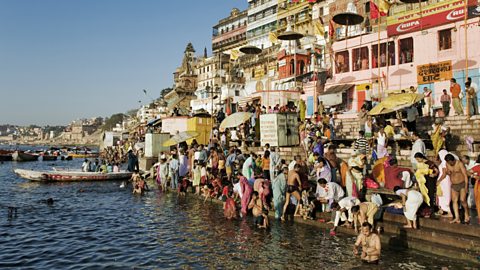Pilgrimage
A pilgrimageA journey which has religious or spiritual significance, usually to an important religious place. is a sacred journey taken for a spiritual purpose ‚Äď to worship, to seek the truth and to visit a site where a significant religious event happened. Hindus have many different important sites of pilgrimage associated with stories of gods and goddesses. Most of them are in India. The river river GangesThe most holy river for most Hindus., and especially the city of Varanasi, is an important site where pilgrims can be found all year round. Kumbh MelaA Hindu festival and pilgrimage, held every 12 years, at which millions of Hindus gather at four sacred rivers in India, including the Ganges, to bathe., probably the biggest pilgrimage on Earth of any religion, takes place once every 12 years.

Purpose of pilgrimage for Hindus
Hindus go on pilgrimage for many reasons, including:
- to seek pure understanding of BrahmanIn Hindu belief, the absolute reality that is the true essence of all existence, God. (or Ultimate RealityHindus believe that Brahman is the Ultimate Reality ‚Äď the source of all life in the universe and the basis of all reality and existence. Brahman is uncreated, infinite and all-embracing.)
- to express their faith
- to fulfil a spiritual promise
- to remember a relative who has died
- to gain insight into stories of the gods and goddesses
- to work towards liberation, or mokshaEscape from the cycle of reincarnation. Term used in the Hindu religion.
Hindus achieve these purposes through ritual bathing, among many other community activities.
Varanasi, a city on the Ganges, has many stories of Shiva associated with it. The Ganges is India’s most sacred river (though Hindus believe that all rivers are sacred). People bathe there to achieve purity of mind and soul.
Kumbh Mela is the world’s largest pilgrimage. It is held at four different sites, and the major Kumbh takes place once every 12 years. Hindus hope that this pilgrimage will allow them to be blessed by God and help them achieve their ultimate goal of moksha through their devotion.
Pilgrimage for Vaishnavites
Worshippers of Vishnu, who are called Vaishnavites, recognise the value of visiting four holy sites in the north, south, east and west of India, called the Char Dham. All four are associated with stories of Vishnu.
Pilgrimage for Shaivites
Worshippers of Shiva, who are called ShaiviteHindus who focus their worship on the god Shiva., recognise the value of many pilgrimage sites associated with stories of the god Shiva. These include 12 centres of pilgrimage all over India that are recognised as UNESCOUnited Nations Educational Scientific and Cultural Organisation. World Heritage Sites.
Question
Which river and city are the most sacred sites for Hindu pilgrims?
The river Ganges and the city of Varanasi.